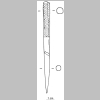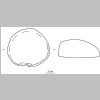5.1 Fibre and skin working tools
Pin beaters, needles, awls and polishing or rubbing instruments attest to fibre and skin working at the site. Pin beaters, which are bone rods that are pointed at both ends, were made out of large mammal long bones, such as those of cattle or horse (fig. 2). The only exception is a pin beater made of a fragment of a whale mandible (table 4). One pin beater of large mammal bone is decorated with lines (fig. 2). Pin beaters were used in weaving (MacGregor 1985, 188-189).

|
Figure 2 Pin beater made from a large mammal bone (cattle or horse) decorated with lines, find no. 5946, Carolingian period.
|
Bone needles, which are quite numerous at Wijnaldum-Tjitsma, perhaps because of the water-sieving, were probably used in fibre and skin/leather working and in making or repairing fishing or fowling nets. All needles of which at least the top is preserved have a round or elongated eye. Most needles (n = 14) were made out of pig fibulae (fig. 3). The pig fibula is a narrow bone with wider ends, which can be made into a needle without much effort. The distal end of the fibula is the top of the needle in which the eye was made. The top of eight pig fibula needles was made narrower to prevent damage to the material that was sewn.

|
Figure 3 Needle or awl made out of a fibula of a young pig, find number 1525, Merovingian period. The hole, which is broken, was made in the unfused distal end of the fibula.
|
The top of six pig fibula needles, however, is more than 1 cm wide. Their wide top made these needles unsuitable for sewing cloth. Wear trace analysis on three of them (two dating to the Merovingian period and one undated) at the Laboratory for Artefact Studies, Leiden University (link to report in supplementary material), showed that they were used on plant fibres, for instance in making or repairing fishing or fowling nets or in basketry. Fishing and fowling were more extensively practiced at Wijnaldum-Tjitsma than at other terpen and this may account for the rather large number of these needles. Another pig fibula with a wide head was used on various materials.
Needles were also made from cattle ribs and long bone fragments of sheep and unidentified mammals. A wide needle and a narrower needle, both of unidentified mammal long bones, were used on plant fibres, just like the pig fibula needles with wide heads. A needle made from unidentified mammal bones was used on several materials, such as skin, plant materials and possibly wool. An irregular object made out of a bone from an unidentified mammal was used on hide or skin. Metal needles were most probably used for sewing fine linen or woollen cloth. The unfinished bone needles indicate that needles were made at the site. Awls were made out of sheep mandibles and metatarsi and out of large mammal long bones (fig. 4). They were made at the site as well. Awls were probably used in skin and coarse fibre working.

|
Figure 4 Awl decorated with crossing lines made out of a long bone from an unknown mammal in the cattle/horse size group, find no. 1001, Merovingian period.
|
Spindle whorls were made out of red deer antler or the caput femoris of cattle (fig. 5). Two antler spindle whorls are disc-shaped (fig. 6). The third, that from the cremation burial, is round, with flat upper and lower sides. Both are decorated with lines. An unfinished cattle caput femoris spindle whorl shows how these whorls were made: the beginning of the hole through the caput femoris is visible in the sawn off bottom of the whorl. The spindle whorls were used for the spinning of wool and plant fibres. Ceramic spindle whorls were also used at the site, including 7th and 8th centuries examples which appear to be made using collected fragments of imported Roman tiles (Galestin 1999).
Five worn and shiny tools are interpreted as polishing or rubbing instruments to polish, clean or smooth linen[3] cloth, skins and other materials, or to rub in skins or cloth with fat. These tools are horse and cattle metacarpi, cattle humeri and a piece of red deer antler. The horse and cattle metatarsi were used without any processing: they are informal bone tools. They are worn at the proximal and distal ends and are shiny all around.
Such worn and shiny metapodia are regularly found at terp sites (Knol 1983; Nieuwhof & Prummel 2007; Prummel 2008). Experiments at the Groningen Institute of Archaeology in 2010 to remove the hairs of a fresh piece of cattle skin by rubbing modern cattle metacarpi and metatarsi over the skin resulted macroscopically in the same type of wear and shine after a short time of use. It proved to be quite hard work. The skins would have perhaps been left to decay for a while or soaked in water with lime before the hairs were removed with this kind of tool. An alternative explanation is that these tools were used to rub in skins with fat to make them waterproof (Barthel 1969).

|
Figure 7 Caput humeri sawn from the left humerus of a cattle and used as a polishing tool, find no. 7025, Carolingian or Ottonian period.
|
Sawn-off proximal articulation heads of the humerus – the caput humeri – were also used as polishing tools (fig. 7). They show post mortem wear on the articulation surface, resulting from moving the object over a surface, for instance cloth or a skin, with the aim to polish or smooth this. Similar objects, with wear on the articulation surface, were found in Carolingian Dorestad (Clason 1980; Prummel 1983). Their shape resembles the glass irons found at Dorestad (Isings 1980).


